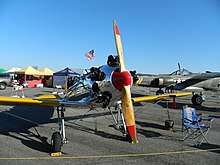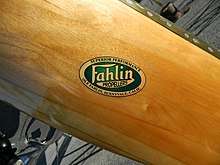Ole Fahlin
Ole (Olaf)[1] Fahlin (May 8, 1901 – January 26, 1992)[2][3] was a Swedish aviator who made his career manufacturing propellers and aviation products in the United States. He also developed prototype airplanes and worked in projects with Chrysler and Lockheed Corporation. His propellers were famous for their performance. During World War II he manufactured propellers for the U.S. government.[4]
Ole Fahlin | |
|---|---|
| Born | Olaf Fahlin May 8, 1901 Sweden |
| Died | January 26, 1992 (aged 90) |
| Known for | Propeller design and manufacturing, design and production of experimental airplanes |
Life and career
Fahlin was born in Bollnäs,[5] Sweden on May 8, 1901,[3][5] to Andrew and Margareta Fahlin (née Larson).[3] His father was an industrialist who was a farm equipment manufacturer. At 19 years of age, Falin followed his father to Germany after World War I during the time of the signing of the armistice. The purpose of the trip was to promote his father's farm equipment products. While in Berlin, Ole Fahlin visited the Johannisthal Air Field where he took flying lessons from Hans Riesler, an old army pilot. When he returned home Fahlin eventually flew for the Swedish Royal Air Service as a pilot. On 21 April 1921, he obtained his international pilot's license from Fédération Aéronautique Internationale. His international pilot license number was 208 and the information was translated in six languages.[4]
United States

In 1923 Fahlin decided to leave Sweden to go to the United States to visit a relative,[6] and was naturalised in 1928.[3] Soon after entering the U.S. he bought a used Curtiss JN-4 Jenny for $300 and started flying it for business and pleasure. He also used it to offer rides to people for $5 per trip.[6] However he was not satisfied with the performance of his plane and started to experiment with different propeller designs which he thought could improve the performance characteristics of the Jenny.[4]
He was so successful in that endeavor that he started getting customers for his propeller designs who could not understand how Fahlin was able to create propellers which performed substantially better than what they thought were state-of-the-art designs.[4][6] Fahlin supplied propellers to private pilots and formula air racers. He would further manually optimize propellers for air racers in the field with the aid of a wood rasp which he used to remove material from the propeller.[7] One of his customers was Rudy Kling, an airplane racer, whose Folkerts Special won the Thompson Trophy in Cleveland, Ohio, using one of Fahlin's propeller designs.[6]
SF-1
As Fahlin's fame increased, Russell B. Nicholas, co-owner of the Nicholas-Beazley Airplane Company, invited him to use his manufacturing facilities in Marshall, Missouri, for free. Fahlin accepted and together with Swen Swanson designed and built their first airplane, the SF-1, which stood for Swanson-Fahlin Model 1. The design and performance of the SF-1 was very successful.[4]
Plymocoupe
In 1935,[1][8][9] following a competition called by the Bureau of Air Commerce, seeking design and construction proposals for an airplane affordable by the masses, Fahlin in cooperation with Swanson designed and produced the Fahlin SF-2 Plymocoupe which utilised the engine of a 1935 Plymouth which also featured design accents, both interior and exterior, borrowed from the same car. After flight testing by the Bureau, the Fahlin plane design was rejected.[9][10][11][12] The Plymocoupe was classified as a "flying automobile" because it utilised the engine of the 1935 Plymouth car.[10] The Plymocoupe design also used many components borrowed from the car including the dashboard and the indicators.[13][14]
Missouri to California

After the dissolution of the Nicholas-Beazley Airplane Company, the Columbia Chamber of Commerce offered Fahlin factory space in Columbia, Missouri, and Fahlin started taking orders directly from the Federal government during World War II while Air Associates distributed his propellers nationwide. Fahlin eventually moved his operations to California in 1962. He was consultant to Lockheed and assisted during the development of the YO-3 quiet plane project, during which he provided in-flight analysis for the propellers developed and tested by Lockheed. His cooperation with Lockheed continued for several years after that project.[4]
Death
Ole Fahlin died on January 26, 1992, in a hospital at Gilroy, California, from pneumonia. On January 31, 1992, a memorial service was held at Morgan Hill, California, during which a "missing man flyby" was performed by 10 vintage airplanes flown by his friends.[2]
Memorial workshop
Fahlin's propeller workshop survives as a working exhibit at the Wings of History museum in San Martin, California.[15][16]
References
- AAHS Journal. 51. American Aviation Historical Society. 2006. p. 14.
- Sport Aviation. 41. 1992. p. 62.
Ole Fahlin, 90, died of pneumonia on January 26 at a convalescent hospital in Gilroy, CA. A memorial service was held on January 31 at Morgan Hill, CA during which a "missing man" fly-by of 10 antique airplanes was made by Ole's friends.
- Who's who in Aviation. Ziff-Davis Publishing Company. 1942. p. 133.
FAHLIN, OLE, President Fahlin Mfg. Co., Columbia, Mo. lies. Columbia. B. Sweden, May 8, 1901; entered U.S. 1923, naturalized 1928. P. Andrew and Margareta (Larson) Fahlin.
- Anita Wright (December 13, 2006). "Building the Vision: Paper prints history of N-B accomplishments". The Marshall Democrat-News.
On April 21, 1921, the Federation Aeronautics International awarded him International Pilot License No. 208, written in six languages.
- "The Ole Fahlin page". Wings of History Museum through Internet Archive. Archived from the original on July 30, 2007.
- The Stanford Engineer. 8. Stanford University School of Engineering. 1978. p. 51.
While there he purchased a war-weary Curtis JN-4 Jenny for $300 and sold rides for $5.00 a passenger. He paid ... His customers were frequently surprised to find that their new Fahlin propeller could outperform their old one by sometimes a considerable margin. The old props were designed using the best technology of the day. How was it possible to ...
- Bonnier Corporation (October 2004). Popular Science. Bonnier Corporation. p. 34–. ISSN 0161-7370.
- Frederick Thomas Jane (1935). Jane's All the World's Aircraft. S. Low, Marston Limited. p. 261.
- AAHS Journal. American Aviation Historical Society. 1999. pp. 120–122.
The Fahlin SF-2 Plymocoupe was also built and tested by the Bureau in the program but was apparently rejected as unsuitable.[...] Fahlin SF-2 Plymocoupe (1935)
- George W. Green (30 June 2010). Flying Cars, Amphibious Vehicles and Other Dual Mode Transports: An Illustrated Worldwide History. McFarland. p. 128. ISBN 978-0-7864-4556-1.
Now, turning to that strange phenomenon, an airplane that thinks it's a car, we run into the Plymocoupe Airplane which sported the portholes and side trim of the 1935 Plymouth. It was labeled a flying automobile because it was powered by an engine manufactured for use in a 1935 Plymouth.
- Sport Aviation. 42. 1993. pp. 172–173.
Damage to Owen's plane of many names - variously known as the SF- 2, Plymocoupe (also Plymacoupe) and ... Ole Fahlin, known for hispropeller designs, and airplane designer Swen Swanson teamed up in planning the airplane for Fahlin ...
- Kimes, Beverly Rae; Clark, Henry Austin, Jr. (2 September 1996). Standard Catalog of American Cars 1805-1942. Krause Publications. p. 1206. ISBN 978-0-87341-428-9.
Ole Fahlin and Swen Swanson built an experimental airplane powered by a 1 935 Plymouth engine converted for aviation use to ... When the Fahlm- Swanson design (called the Plymocoupe or SF-2) failed to win the government contest and ...
- Flying Magazine. August 1935. p. 96. ISSN 0015-4806.
Here is a Plymouth Sedan and its offspring, the flying Plymo-Coupe. Many Plymouth auto parts are used in the plane. Right side of the Plymo-Coupe power plant showing that all.
- Flying Magazine. October 1935. p. 237. ISSN 0015-4806.
- "About the Propeller Shop". Wings of History Museum.
- http://wingsofhistory.org/